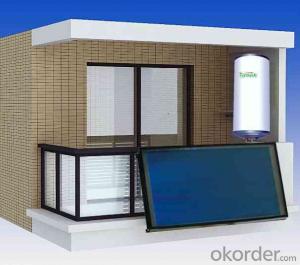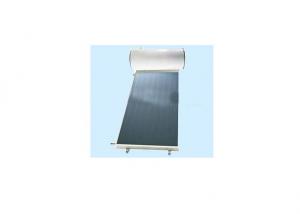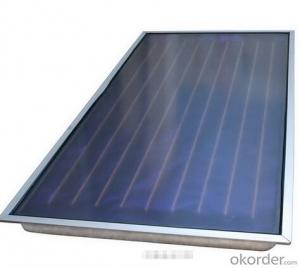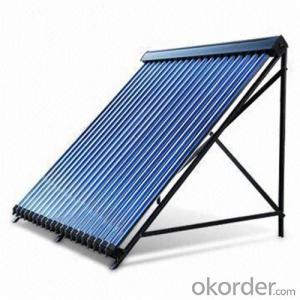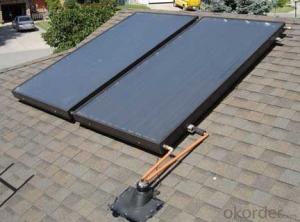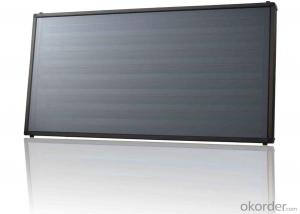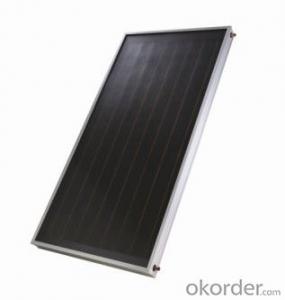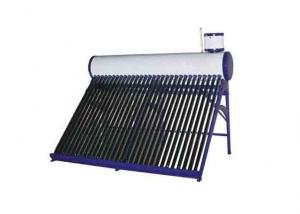Heat Pipe Vacuum Tubes Solar thermal collector with most reasonable price
- Loading Port:
- Shanghai
- Payment Terms:
- TT OR LC
- Min Order Qty:
- 500 pc
- Supply Capability:
- 10000 pc/month
OKorder Service Pledge
OKorder Financial Service
You Might Also Like
Heat Pipe Vacuum Tubes Solar thermal collector with most reasonable price China manufacturer : The heat pipe series of solar collectors are always connected with existing heating supply device. The selective coating on the inner glass of the evacuated tube converts solar energy into heat energy and transfers heat to the heat pipes by aluminium fins. The liquid in the heat pipe changes into vapour and rises to the condensation end .The heat passes through the heat exchanger into the inner wall of the vacuum tube and then transfers through the copper pipes into the liquid..The transference of heat into the liquid creaters a continuous circulation as long as the collector is heated by the sun.
FEATURE:
1. Workable at water pressure up to 0.6Mpa.
2.Possible to be connected with existing energy source.
3. Water tank may not be installed together the collector.
4.The pipeline is made of copper and conducted by heat transfer medium liquid. The vacuum tube does not take water.The coating is high strength stainless steel with air flow design ,which is furnished in good style.
5.Possible to withstand high pressure in working condition.
6.Module design, free combination to meet the demand of large water consumption.
Feature:
1,header pipe materia
2,manifold material:aluminum alloy
3,tube dimensions:l1500/47mm or 1800/58
4,vacuum tube coating material:AL-N/AL or AL/N-SS-Cu
5,insulation layer:compressed rock wool
6,test pressure:9bar
7,working pressure:6bar
8,collector mounting:flat roof/inclined roof
9,angle of operation:5 degree-90degrees
10,heat preservation:72 hours
11,hail resistance:25mm
12,copper heat pipes for rapid heat transfer
Primary competitive advantages:
1 ISO,CE,SOLARKEYMARK
2 reasonable price and good quality
3 prompt delivery
4 environmental protection
5 OEM order is available
6 experience of export to 70 countries
7 international quality warranty:10 years for solar cillector and 15 years for vacuum tube
8 runner :copper runner 35mm, 40mm, 42mm
- Q:Can solar collectors be used in cloudy climates?
- Yes, solar collectors can still be used in cloudy climates. While the efficiency of solar collectors decreases on cloudy days, they can still generate a significant amount of energy. Additionally, advancements in technology have made it possible for solar collectors to capture and convert diffuse sunlight, allowing them to function even in overcast conditions.
- Q:How do solar collectors affect carbon emissions?
- Solar collectors can significantly reduce carbon emissions by harnessing the power of the sun to generate clean and renewable energy. By using solar collectors to produce electricity or heat, we can reduce our dependence on fossil fuels, which are the primary source of carbon emissions. Therefore, solar collectors play a crucial role in mitigating climate change and promoting a sustainable future with lower carbon emissions.
- Q:Can solar collectors be used in high-rise buildings?
- Yes, solar collectors can be used in high-rise buildings. With advancements in technology, solar collectors can be installed on rooftops or integrated into the building facades of high-rise structures. These collectors can harvest solar energy to provide electricity, heat water, or contribute to the building's overall energy needs. However, it is important to consider the building's orientation, shading from nearby structures, and available roof space when designing and installing solar collectors in high-rise buildings.
- Q:What is the optimal orientation for solar collectors?
- The geographic location and specific goals of the solar energy system determine the best orientation for solar collectors. Generally, solar collectors should face south in the northern hemisphere and north in the southern hemisphere to receive maximum sunlight throughout the day. By directing towards the equator, solar collectors can capture the most direct and intense sunlight, resulting in higher energy production. This is especially important for solar thermal collectors that rely on direct sunlight for heating fluids or generating steam. However, several factors can influence the optimal orientation. For example, if the solar collectors are primarily used for electricity generation through photovoltaic (PV) panels, the orientation may be affected by peak electricity demand times. In such cases, the collectors can be tilted towards the west to align with the late afternoon peak demand, increasing electricity output during that time. Furthermore, local climate and shading considerations should be taken into account. Trees, buildings, or other obstructions can cast shadows on the solar collectors, reducing their efficiency. Assessing shading patterns throughout the day and year can help determine the best orientation and tilt angle to minimize shading. Moreover, the tilt angle of solar collectors also impacts efficiency. The tilt angle is usually optimized to maximize annual energy production by balancing higher winter production with lower summer production. The ideal tilt angle varies based on the location's latitude and specific objectives of the solar energy system. To summarize, the preferred orientation for solar collectors is generally south-facing in the northern hemisphere and north-facing in the southern hemisphere. However, peak demand, shading, climate, and tilt angle are additional factors that should be considered to maximize energy production and efficiency of the solar energy system.
- Q:Can solar collectors be used for sterilizing medical equipment?
- Yes, solar collectors can be used for sterilizing medical equipment. Solar collectors can generate heat by absorbing sunlight and converting it into thermal energy. This heat can be utilized for various applications, including sterilization. Solar autoclaves, for example, use solar collectors to heat water or generate steam, which can then be used to sterilize medical equipment. Solar-based sterilization methods are particularly useful in areas with limited access to electricity or where a reliable power supply is not available. By harnessing the power of the sun, solar collectors provide a sustainable and cost-effective solution for sterilizing medical equipment in such settings. Furthermore, solar-based sterilization techniques are environmentally friendly since they do not rely on fossil fuels or produce harmful emissions. This makes them an attractive option for promoting sustainable healthcare practices and reducing the carbon footprint associated with sterilization processes. However, it is important to note that solar collectors alone may not be sufficient for complete sterilization of all medical equipment. They can provide the necessary heat for sterilization, but other factors such as proper cleaning, packaging, and maintenance of sterility should also be considered. Additionally, the size and capacity of the solar collectors need to be appropriately designed to meet the specific requirements of the medical facility's sterilization needs. In conclusion, solar collectors can indeed be used for sterilizing medical equipment, offering a sustainable and cost-effective alternative to traditional sterilization methods, especially in areas with limited access to electricity. However, careful consideration and integration of other sterilization practices are necessary to ensure the highest level of sterility and safety.
- Q:Can solar collectors be used in combination with agricultural irrigation systems?
- Yes, solar collectors can be used in combination with agricultural irrigation systems. Solar collectors can provide the energy needed to power irrigation pumps, which reduces reliance on fossil fuels and decreases operational costs. This sustainable solution harnesses solar energy to pump water and supports the efficient and eco-friendly irrigation of agricultural lands.
- Q:Are solar collectors suitable for countries with limited sunlight?
- Despite the limited sunlight in certain countries, solar collectors remain a viable option. Although their efficiency may be reduced compared to countries with abundant sunlight, solar collectors are able to convert sunlight into usable energy. It is worth noting that even in countries with limited sunlight, there is still some level of solar radiation available throughout the year. In countries with limited sunlight, it is crucial to consider the type and design of solar collectors used. For example, opting for solar thermal collectors that prioritize capturing heat rather than generating electricity can be more advantageous in such regions. These collectors can be utilized for heating water or space heating, which are significant energy demands even in countries with limited sunlight. Moreover, advancements in solar technology have resulted in the creation of more efficient solar collectors that can generate energy even in low-light conditions. For instance, some solar panels are specifically designed to capture diffuse light, making them suitable for regions with limited direct sunlight. Furthermore, the integration of solar collectors with other renewable energy sources, such as wind or hydro power, can help compensate for the limited sunlight and ensure a more reliable and sustainable energy supply. Therefore, while solar collectors may not be as efficient in countries with limited sunlight, they can still serve as a viable and valuable renewable energy option, especially when combined with other renewable sources and optimized for the specific conditions of the region.
- Q:Are there any challenges in integrating solar collectors with existing heating systems?
- Yes, there can be challenges in integrating solar collectors with existing heating systems. One challenge is ensuring compatibility between the two systems, as different heating systems may have varying requirements and specifications. Additionally, the physical integration of solar collectors into an existing infrastructure can pose logistical challenges, such as finding suitable locations for installation and ensuring proper plumbing and wiring connections. Furthermore, the efficiency and performance of the integrated system can be affected by factors like system design, sizing, and control strategies, requiring careful planning and optimization. Overall, integrating solar collectors with existing heating systems requires careful consideration and expertise to overcome these challenges successfully.
- Q:Can solar collectors be used for heating tourist attractions and theme parks?
- Yes, solar collectors can be effectively used for heating tourist attractions and theme parks. Solar thermal collectors are capable of harnessing the sun's energy to heat water or air, which can then be used for space heating or hot water needs in these establishments. Implementing solar collectors not only reduces reliance on fossil fuels but also provides a sustainable and environmentally friendly solution for meeting heating requirements in tourist attractions and theme parks.
- Q:Can solar collectors be used in greenhouses?
- Yes, solar collectors can be used in greenhouses to harness solar energy for heating and powering various systems within the greenhouse.
1. Manufacturer Overview |
|
|---|---|
| Location | |
| Year Established | |
| Annual Output Value | |
| Main Markets | |
| Company Certifications | |
2. Manufacturer Certificates |
|
|---|---|
| a) Certification Name | |
| Range | |
| Reference | |
| Validity Period | |
3. Manufacturer Capability |
|
|---|---|
| a)Trade Capacity | |
| Nearest Port | |
| Export Percentage | |
| No.of Employees in Trade Department | |
| Language Spoken: | |
| b)Factory Information | |
| Factory Size: | |
| No. of Production Lines | |
| Contract Manufacturing | |
| Product Price Range | |
Send your message to us
Heat Pipe Vacuum Tubes Solar thermal collector with most reasonable price
- Loading Port:
- Shanghai
- Payment Terms:
- TT OR LC
- Min Order Qty:
- 500 pc
- Supply Capability:
- 10000 pc/month
OKorder Service Pledge
OKorder Financial Service
Similar products
New products
Hot products
Hot Searches
Related keywords
